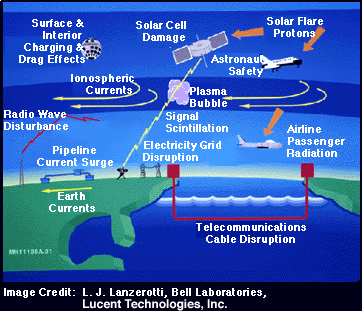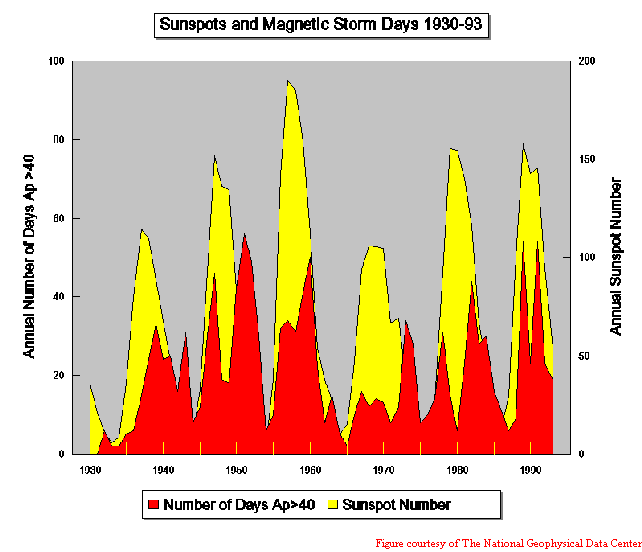
For additional background information relevant to this investigation:
Background:
The process of fusion liberates energy within the core of the sun. A small part of
this energy produces its magnetic field. Variations in the magnetic
fields (magnetic fluxes) result in solar events, such as sunspots, coronal mass ejections (CMEs),
and solar tornadoes. This solar activity results in larger than normal amounts of radiation
(from radio waves to gamma rays) and energetic particles (such
as high energy protons and electrons) ejected into space. Just
as moving air molecules on Earth constitute a wind, these energetic
particles make up the solar wind. This wind and solar activity are measured by several spacecraft,
including the Advanced Composition Explorer (ACE). The solar events,
when interacting with the Earth’s magnetosphere (magnetic field), creates profound effects.
These effects may
include:
Note to the learner: Ionospheric currents, plasma bubbles, and signal scintillation
are not discussed in this lesson, even though they appear in the
graphic below.

For additional background information relevant to this investigation:
Procedure:
(The procedure may be printed out and answers written on it, or separate paper maybe used. See in your teacher for instructions.)
Many recent space weather events have made headlines and caused inconveniences. In this exercise, we will study some of the effects and relate them to space weather measurements.
1. Visit at least three of the five preceding links. Describe what these links tell you:
____________________________________________________________________________
____________________________________________________________________________
____________________________________________________________________________
____________________________________________________________________________
Using the fourth link, calculate the average number of solar proton events per year since 1976, and show your calculations below.
2. DATA REPRESENTATION: From your reading, you may have noticed that the strength of the solar wind is represented by the quantity called”solar proton flux.” This measures how many protons, ejected by the Sun, pass a point in space in a given time frame. (You could do the following exercise either on graph paper with a pencil and/or colored pencils, or using a spreadsheet program.) Working on your own or with a partner, determine the best way to represent the data in the table graphically. Emphasize when and how many occurred, and their relative strength. Begin by plotting no. of storms (proton events) vs time. Design a second plot to look at the intensity of the storms. (If you’ve had at least Algebra 2: when might you consider using a log scale?)
3. Look at your graph, and look at the graph of sunspot cycles:
http://image.gsfc.nasa.gov/poetry/sunspot/cycle.html
Describe any patterns, trends and correlations that you observe with your graphs:
I have observed the following PATTERNS (limit your observations to only one graph):
_____________________________________________________________________________
_____________________________________________________________________________
_____________________________________________________________________________
_____________________________________________________________________________
I have observed the following CORRELATIONS (relate any two graphs and patterns to each other):
_____________________________________________________________________________
_____________________________________________________________________________
_____________________________________________________________________________
_____________________________________________________________________________
4. As an evaluation, refer to the following charts.

http://www.nas.edu/ssb/ssispe.gif

Note: Ap is a measure of magnetic activity near Earth
http://www.nas.edu/ssb/ap_ssn.gif
How is your analysis
correct? How might you change it after seeing
these two charts?
ANALYSIS CORRECT:__________________________________________________________
______________________________________________________________________________
ANALYSIS CHANGES:__________________________________________________________
______________________________________________________________________________
Coding:
Maryland Core Learning Goals (Science):
1.2, 5.1
National Standards (Science):
A.4, F.5, D.3.
National Standards (Geography): 7.2, 8.2.
National Standards (Mathematics): 4.4, 5.2.
Investigation Discussion and Questions
Credits:
Pat Keeney GESSEP Program
queen3@access.digex.net
Daniel Hortert GESSEP Program
howard6@access.digex.net
Dr. Eric R. Christian
ACE Deputy Project Scientist
cosmicopia@cosmicra.gsfc.nasa.gov
Dr. John Krizmanic
Astroparticle Physicist
cosmicopia@cosmicra.gsfc.nasa.gov
Beth Barbier
ACE Outreach Specialist
High Energy Astrophysics
cosmicopia@cosmicra.gsfc.nasa.gov